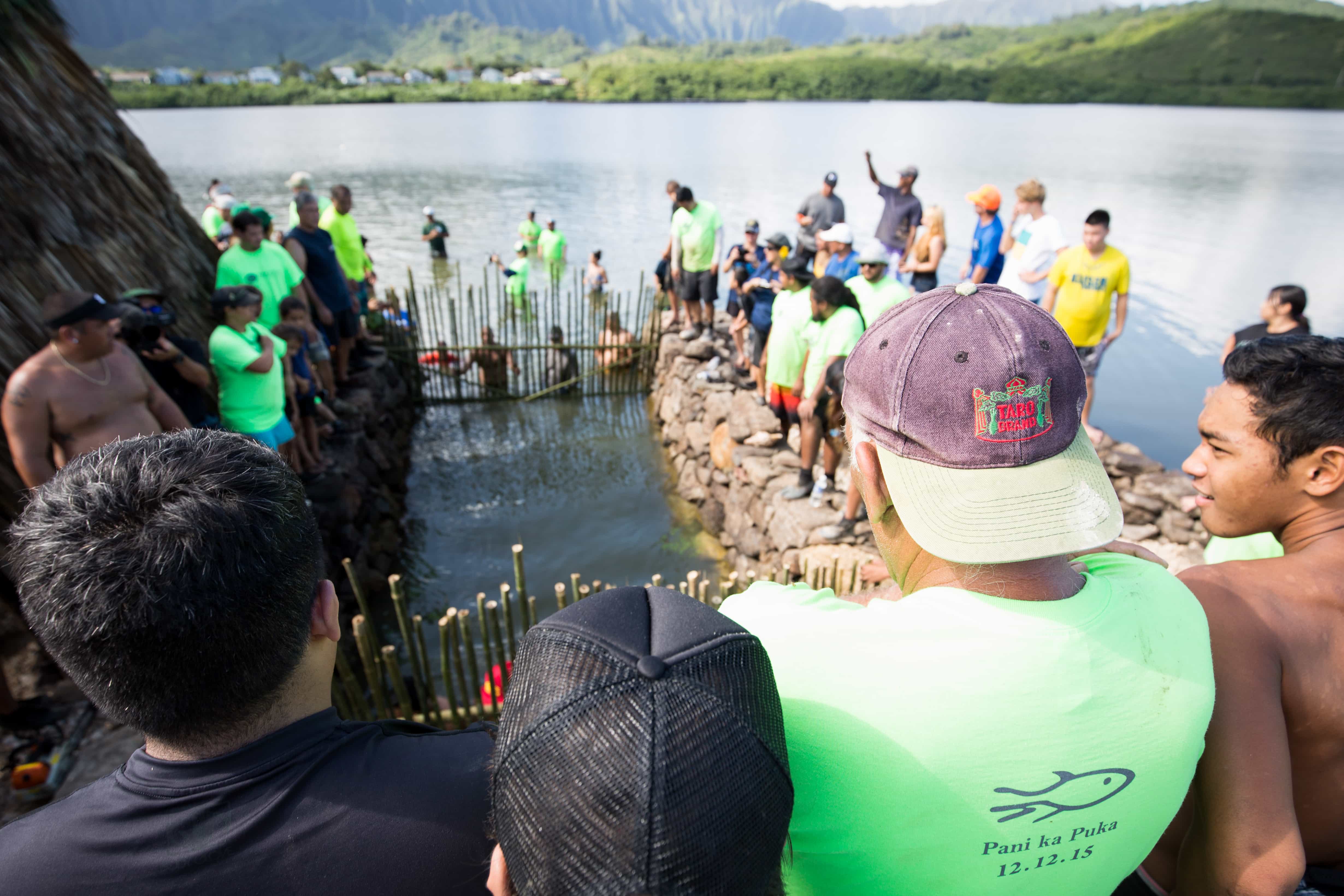Production
Hawaiian historian Samuel Manaiakalani Kamakau noted that, “Fishponds were things that beautified the land. A land with many fishponds was called momona (fat).” It was with this quote in mind along with our desire to restore the abundance of He’eia Fishpond that we named this program.
The goal of this community-based economic development program is to research, develop, and cultivate various products from the fishpond and make them available to the public. In doing so, we aim to mutually benefit both the fishpond and those whom it can nourish.

Aquaculture
Methods of aquaculture at He‘eia fishpond have changed over the decades as well as the environmental conditions in and out of the fishpond, which impact those methods. Paepae o He‘eia is committed to growing safe and healthy food within the fishpond by combining the lessons and practices of our ancestors with the best available technologies of today. By adapting our aquaculture methods to the current state of the pond, we hope to provide physical nourishment to our `ohana and community, as our ancestors did, into the future.
Fish – Over the past 15 years, Paepae o He‘eia has successfully raised different species of fish using net-pen culture. This style of fish aquaculture was necessary because of the numerous holes in our kuapā (fishpond wall) through which the fish could swim out of the pond if not for the netted pens. In December 2015 we closed the largest hole in our kuapā which signaled a new beginning in our efforts to raise fish, especially herbivorous fish. Since then we have learned a lot about weather patterns, seasonality of fish, severe environmental changes, water quality and how our kūpuna may have run this pond. Therefore, we are still in the “watch, learn, and experiment” phases of our fish farming and hope to one day be able to bring our fish to market.


Samoan Crab– We currently sell Samoan Crab (mangrove/mud crab) to the public approximately once per month. If you are interested in getting on the list to purchase crab, please visit this website and add your contact information. It is a very simple process and you will be contacted when it is your turn to purchase crab. We sell our crab at $10 per pound and is occasionally featured as a daily special at select restaurants.
Resource Sharing
He’eia Fishpond contains a wealth of resources that we are happy to make available to our community. Listed are some of the resources that we offer to the community. Please contact us for more information about these resources and to check on availability.
Limu – Farmers have used this invasive limu that grows in the fishpond as mulch to fertilize their gardens or lo’i with very productive results. The invasive limu we have are particularly high in potassium which is a critical nutrient for root crops. This is normally a “pick-it-yourself” type of resource where we will direct you to the spot and then you must gather it yourself. Occasionally, we do large group invasive removals and we have lots of bags that are available to pick up from our parking lot. Call for more information.
Mangrove Firewood – Mangrove is an introduced, invasive tree which grows abundantly around the edge of He‘eia Fishpond. The dense, hard wood, similar to Kiawe, is great for BBQ’s, imu, smoke houses, etc. We occasionally have this wood available as it is removed from the fishpond. Call for availability.
Mangrove wood – Mangrove wood is also resistant to termites and bugs, ideal for hālau construction, hula implements, picture frames, lomi sticks, etc. Call for availability and accessibility.

Invasive Seaweed Removal
 Once the wall is returned to a functioning state, other restorative activities can take place to improve the environment within the pond. One such important activity is the removal of invasive limu (seaweed). The reef adjacent to He‘eia Fishpond is blanketed by mainly three species of invasive limu: Kappaphycus, Acanthophora spicifera, and Gracilaria salicornia. Each invasive limu has a unique story of introduction to Hawaii’s waters but, most importantly, fragments of these limu float into the pond at high tides and then grow abundantly.
Once the wall is returned to a functioning state, other restorative activities can take place to improve the environment within the pond. One such important activity is the removal of invasive limu (seaweed). The reef adjacent to He‘eia Fishpond is blanketed by mainly three species of invasive limu: Kappaphycus, Acanthophora spicifera, and Gracilaria salicornia. Each invasive limu has a unique story of introduction to Hawaii’s waters but, most importantly, fragments of these limu float into the pond at high tides and then grow abundantly.
Paepae o He’eia has removed limu since 2004 with the help of community partners such as The Nature Conservancy, Hawaii Department of Aquatic Resources, Oahu Invasive Species Council, and countless individual volunteers. Since 2004, Paepae o He‘eia has removed over 50 tons of invasive limu from He‘eia Fishpond. The invasive limu is gathered by hand or net and placed into large bags. Finally the limu is used by our mauka partners as fertilizer on their lo’i kalo, uala patches, or any other type of garden. Beginning in 2019, Paepae o Heʻeia will partner with the Heʻeia National Estuarine Research Reserve System (NERRS) and The Nature Conservancy to use the Supersucker in the fishpond to remove as much invasive seaweed as possible from within the fishpond.
